The AMD Kabini Review: A4-5000 APU Tested
by Jarred Walton on May 23, 2013 12:00 AM ESTKabini Windows 8 Laptop Performance
With the SoC and “lighter device” benchmarks out of the way, let’s also look at what Kabini offers for a full laptop experience. Let me preface this section by simply stating many of our laptop benchmarks really aren’t a good fit for an APU like Kabini—e.g. doing 3D rendering or x264 HD encoding on such a chip is just asking for poor performance. We’re also looking at different OS configurations (Windows 7 vs. Windows 8, IE8/9 vs. IE10), so there’s a slightly higher potential for margin of error here.
Our current list of laptops includes AMD's Brazos E-350 (MSI X370), Kabini A4-5000, and Trinity A10-4600M; on the Intel front we have i7-3517U (Dell XPS 12) and Pentium 2020M (a late addition when we managed to get a laptop for short-term testing). Both of the Intel chips are 22nm parts, but note that the Pentium chip is a 35W part. Sadly, we have not yet been able to get a Pentium 2117U as a comparison. [Note: Some laptops are still being tested on some of the benchmarks; their scores will be added/updated as they complete.]
We do want to see what sort of gains are present relative to Brazos, however, so let’s get started. We’re presenting an abbreviated look at performance here, but we have the full set of benchmark results in Mobile Bench, including some of our older benchmarks that we’ve run against Brazos and other laptops prior to 2013. There are two main questions to consider for each benchmark: how much faster is Kabini than Brazos (and where does it place relative to other options), and does Kabini provide enough performance to handle the task represented by the benchmark?
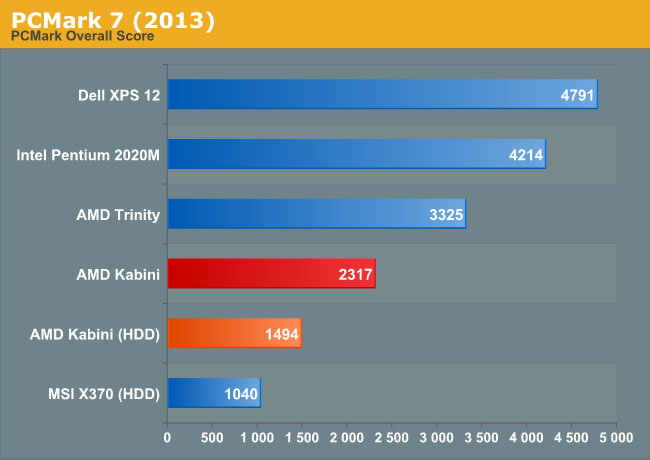
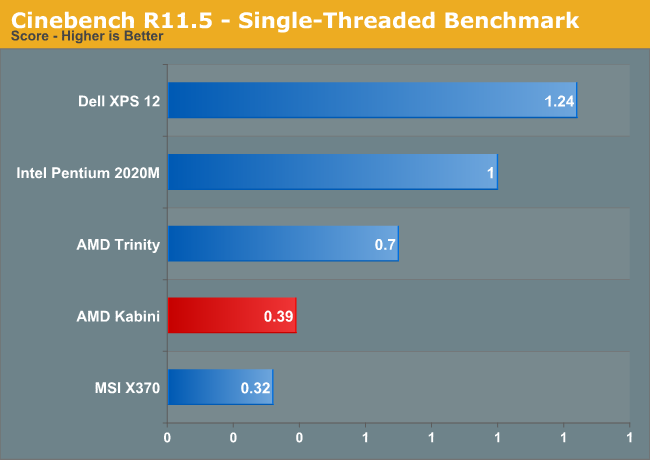
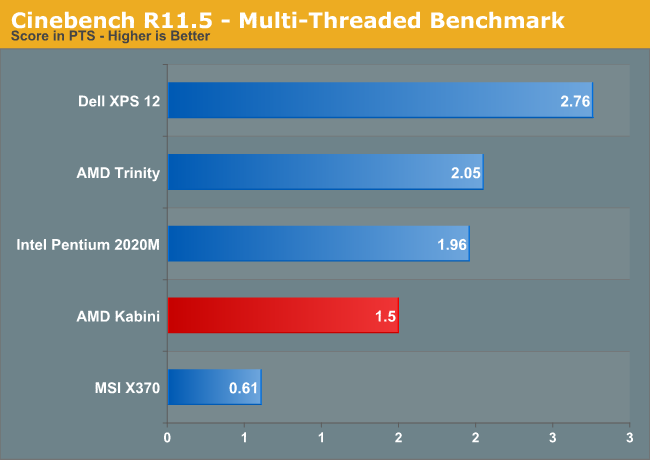
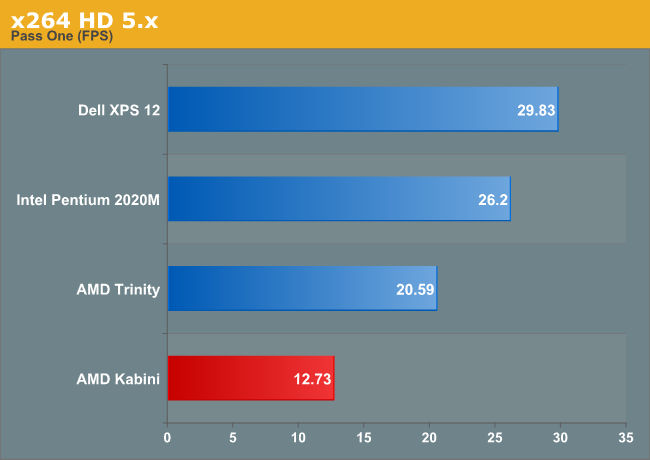
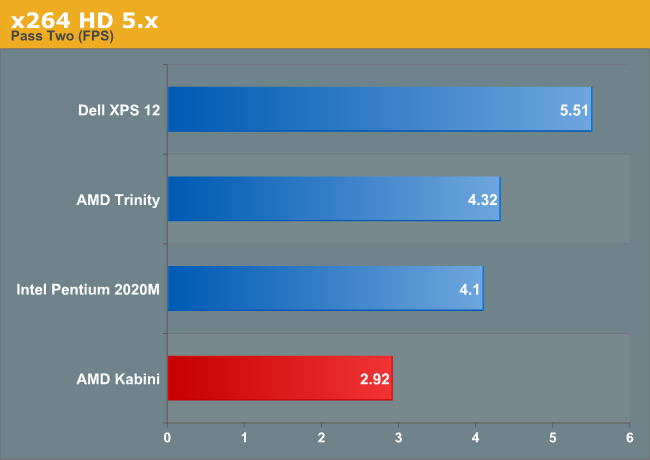
Starting with PCMark 7, we have both HDD and SSD results. As usual, the presence of an SSD boosts performance in the overall score by more than 50%, so Kabini with an SSD can feel far more responsive than Ivy Bridge with an HDD, depending on the task. Relative to Brazos, even with an HDD on both laptops, Kabini is nearly 50% faster. ULV Ivy Bridge on the other hand offers twice the performance of Kabini in the overall score, though Quick Sync skews that pretty heavily. Looking at the individual results, ULV IVB is around 30-50% faster on most CPU tasks, and it’s even a bit faster on the GPU side in most areas as we’ll see in a moment.
Update: We've added Pentium 2020M to the above charts, which lacks Quick Sync support and runs at a maximum clock speed of 1.8GHz. It's clearly slower than the i7-3517U in the Dell XPS 12, but it's also still a healthy step up from Kabini in terms of performance. The 2020M is a full 35W part, like the A10-4600M, and it tends to slightly outperform Trinity on CPU tasks while trailing in GPU performance. On the Kabini front, however, even the Pentium 2020M is able to lead on nearly all the performance metrics.
The CPU performance testing of x264 HD 5.x and Cinebench confirm the CPU deficit AMD faces with Kabini. In heavily threaded workloads, Ivy Bridge ULV is 50-100% faster, but the real problem is in the single-threaded workloads. A single Jaguar core in Cinebench manages to score just 0.39 compared to IVB ULV’s score of 1.24, so worst-case Kabini is one third the speed of Ivy Bridge. Standard Voltage Trinity APUs are likewise a big step up from Kabini, offering roughly twice the CPU performance in some cases. Of course, the power draw from standard Trinity tends to be far higher than Kabini.

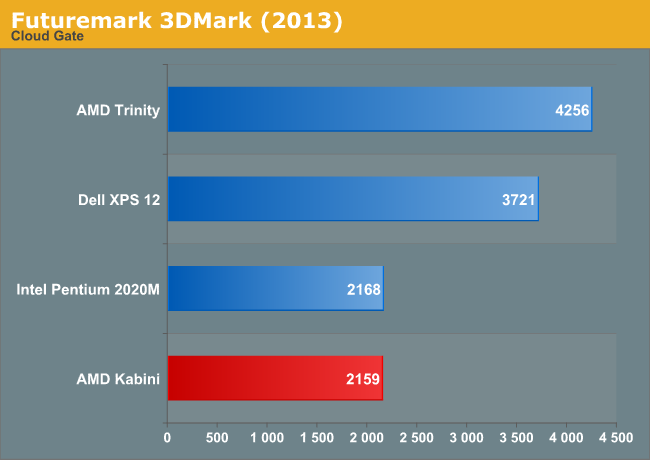
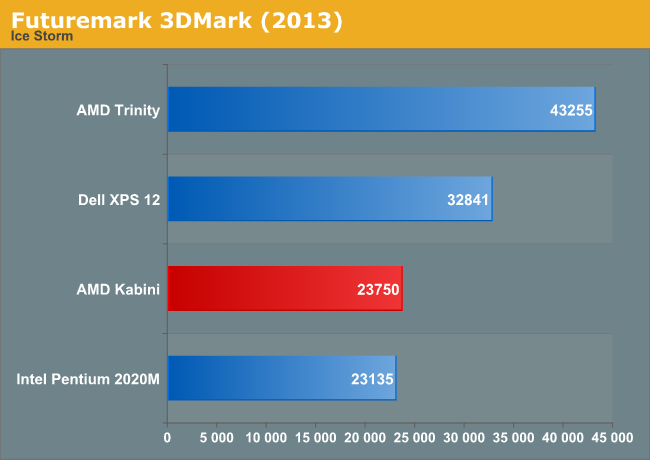
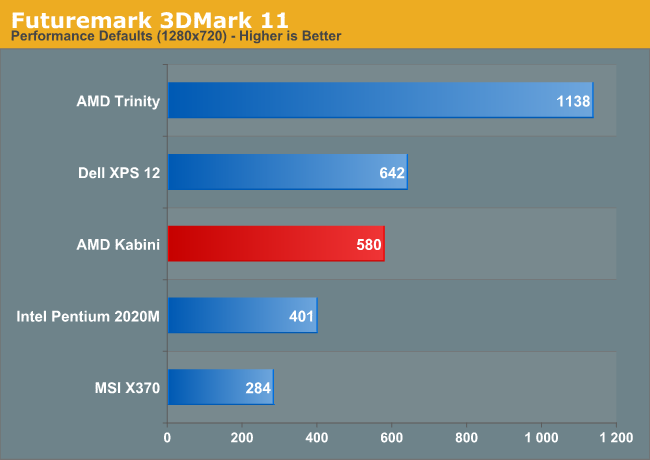
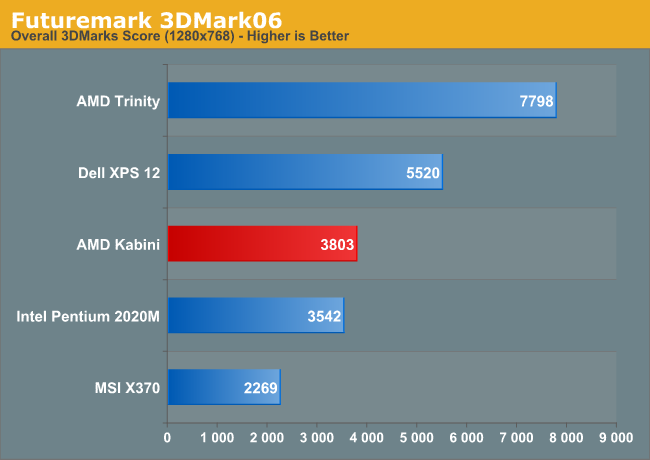
Quickly looking at the 3DMark results, if you were hoping Kabini would be fast enough to handle modern games at moderate detail settings, the relative standings in 3DMark should help prep you for what’s to come. The A10 Trinity can handle many titles at moderate details, but even it struggles with many of the latest releases; Kabini has about a third of the total GPU compute performance of Trinity, and while it’s a bit faster than that in some games, for the most part it’s best suited for older games that don’t require as much from the CPU or GPU.
As for Intel's chips, while the Core i7 ULV part ends up faster than Kabini, the same can't be said of the Pentium 2020M; it's a tie in some tests but falls behind (sometimes significantly, e.g. 3DMark 11) in others. As neither chip is really fit for high-end graphics work, it's not really a major concern. If you want decent graphics performance, you're going to want more than either Kabini or Ivy Bridge has to offer.










130 Comments
View All Comments
Gaugamela - Friday, May 24, 2013 - link
I'll beg to disagree with that. As a non-promotional price, for a notebook with a 1080p touchscreen display I think that 500$ is more than fair. As for promotions happening your line of reasoning seems to assume that discounts will only affect Intel notebooks which isn't clearly the case.While you may get cheap Ivy Bridge notebooks when in promotion, go search for cheap Trinity/brazos notebooks with promotions and you'll find them even cheaper. The same will be said of Temash/Kabini notebooks.
I fail to understand why you don't seem to acknowledge that.
Or the proposition of an APU that beats Pentiums and Celerons in performance (excluding single-thread performance, which is much less relevant nowadays) and has superior battery life.
Will Atom and Haswell Pentiums offer better performance/efficiency/price ratio? It remains to be seen.
whyso - Friday, May 24, 2013 - link
Depends really. With a 1080p screen its a good price. Sales happen all the time. Yes you can and will get i3 ULV systems for cheap and can get kabini systems for cheap. I'm simply saying given the fact that these promotion happen all the time literally (go to newegg laptops, sort by price-lowest and more than 75% of the notebooks on that page are on sale) you have to take these things into consideration. Kabini is competing against discounted but perfectly fine notebooks in this segment. You can get a nice lenovo g580 with SV i3 for $350. Any promotion that runs with a kabini notebook will have to match that price/perf and kabini is much weaker than SV i3.http://www.newegg.com/Product/Product.aspx?Item=N8...
whyso - Friday, May 24, 2013 - link
Sale % was taken from .ca g580 price from .com for .ca about half are on sale.dusk007 - Thursday, May 23, 2013 - link
The performance quite poor and notebookcheck doesn't really tell a different story. An i5 is the right CPU to compare it too because it runs in the same performance envelope. With all the other stuff that goes into a decent notebook or tablet/hybrid the CPU cost alone does make that much of a difference.The problem with Kabini is Single Threaded performance which matters for responsivness in plain old office work loads. Which is what most of these notebooks do. x264, cinebench, ... none of that really matters.
And gaming. In game low settings don't do much for CPU requirements and that is why even at low many games aren't playable. Something Intel can offer despite its HD 4000 which has nowhere near the reputation of AMD's GCN. If all you want is an office notebook for some casual gaming like a bit of Starcraft. An i5 is still a worthwhile investment.
Gaugamela - Thursday, May 23, 2013 - link
The i5 is the right CPU because it runs in the same performance envelope??????? How about no??How much more does the i5 cost?
andrewaggb - Thursday, May 23, 2013 - link
Well theres two arguements. One is cost, and yes amd will come in cheaper because intel likes their margins. So if cost is your primary motivator than this chip looks good.The other argument is performance/watt and peak performance, both of which make an i5 look much better than this chip.
Now it's true an i5 doesn't scale down to 3.9W, so in that market this chip appears to be a real contender and the one to beat. But that's not the version that was tested here today so we don't know that for sure.
Personally, I'm disappointed, and think haswell will compare very favorably in all metrics except price. I'm not sure haswell will be tablet suitable though, where some sku's of this chip should be.
Not saying this chip is terrible, just saying for anything 8-9W and up it seems to me haswell will be the clear choice if price isn't a major factor.
Gaugamela - Friday, May 24, 2013 - link
And this is a product that competes on price and battery life. Not performance as Haswell does.dusk007 - Saturday, May 25, 2013 - link
Just that it does compete on performance doesn't mean performance isn't valuable information. How much speed loss are you dealing with when going with cost effectiveness. This isn't a smartphone CPU that will ultimately end up running different software. It is still Windows and the same games and programs as an i5 is used for.The cost difference in the end product isn't that huge or insurmountable. The buyer would like to know how much they get when paying up or who much they loose when going cheap. Comparing it only with Atoms would be cheating and something marketing folks do not a review site that wants to have some reputation.
These chips don't go into Smartphones not even Tablets (that is Temash) they go where 15W Haswells will go and 2/3 of those sub $800 notebooks BOM is still none CPU related. So even if Kabini was given away for free the notebooks would still cost something.
Parhel - Friday, May 24, 2013 - link
But price is always a major factor. It's the "majorest" factor. This is a site for enthusiasts (read geeks) but think of the person at the AT&T store who picks the 2 or 3 generation old iPhone because it's $50 cheaper.tunaman - Thursday, May 23, 2013 - link
AMD set the standard with x64 that Intel evetually agreed was superior and joined. With the introduction of these hUMA (fully shared CPU and GPU memory) chips AMD has again set the standard that Intel will have to copy.As I've said before; Intel hasn't been a tech leader in a decade and, again, they'll be playing catch up once they cave to AMD's superior design. But by then, just as has been true for years, Intel graphics and multitasking will continue to lag behind AMD. Intel's only bragging right is saving one or two watts and slapping an "Intel Inside" tatoo on products, but charging twice as much for it. http://goo.gl/OItwV